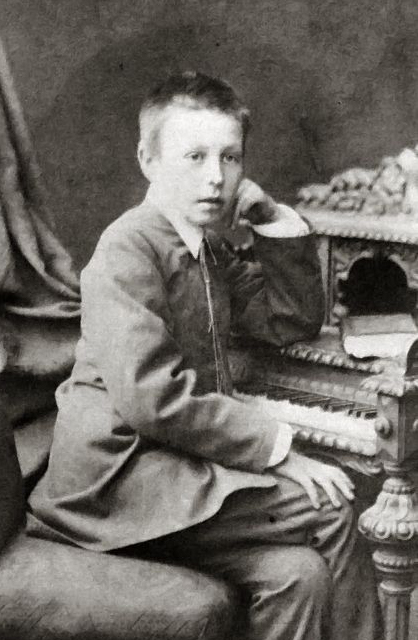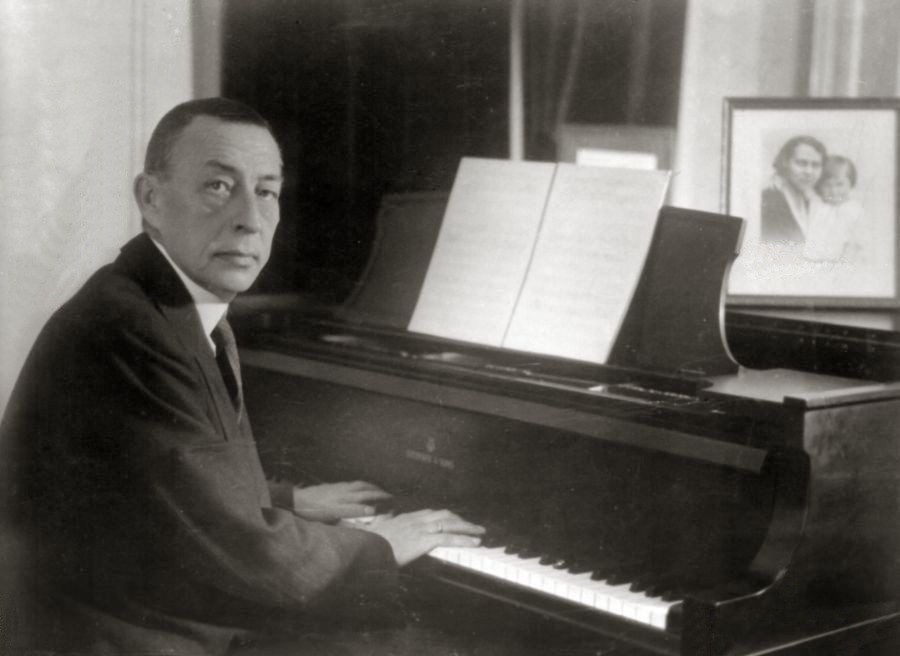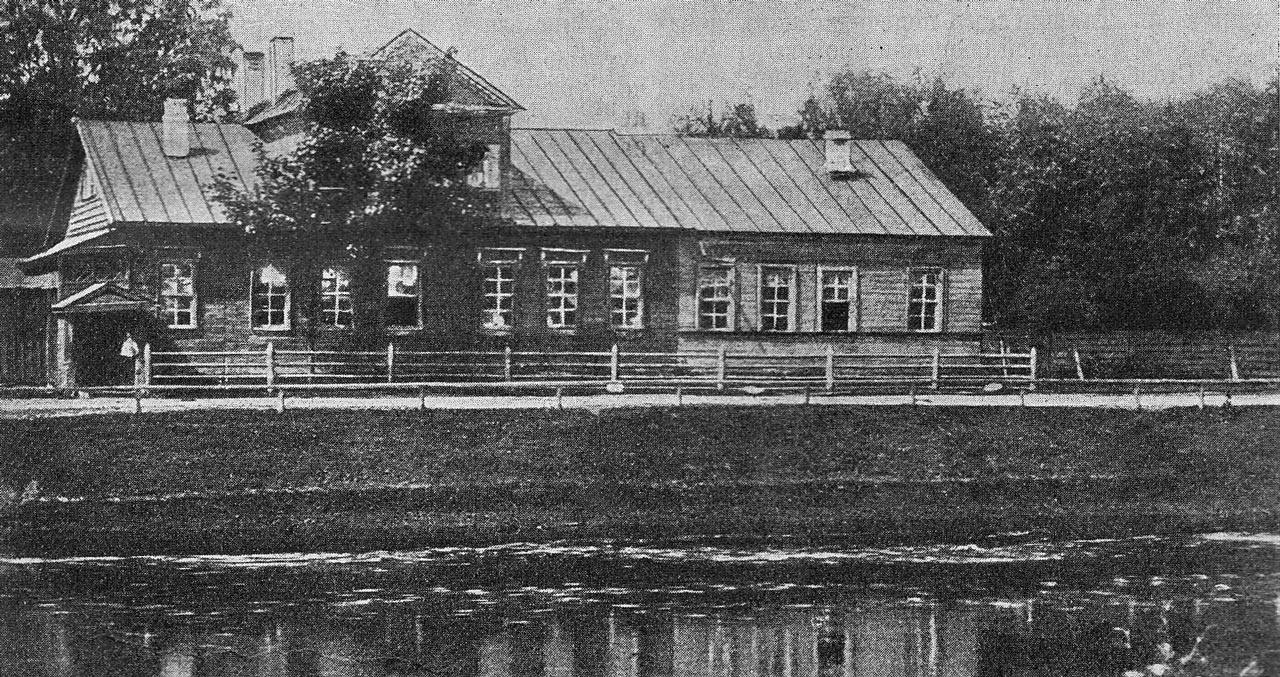|
Rachmaninoff
Sergei Vasilyevich Rachmaninoff; in Russian pre-revolutionary script. (28 March 1943) was a Russian composer, virtuoso pianist, and conductor. Rachmaninoff is widely considered one of the finest pianists of his day and, as a composer, one of the last great representatives of Romanticism in Russian classical music. Early influences of Tchaikovsky, Rimsky-Korsakov, and other Russian composers gave way to a thoroughly personal idiom notable for its song-like melodicism, expressiveness, dense contrapuntal textures, and rich orchestral colours. The piano is featured prominently in Rachmaninoff's compositional output and he used his skills as a performer to fully explore the expressive and technical possibilities of the instrument. Born into a musical family, Rachmaninoff began learning the piano at the age of four. He studied piano and composition at the Moscow Conservatory, from which he graduated in 1892, having already written several compositions. In 1897, following the ... [...More Info...] [...Related Items...] OR: [Wikipedia] [Google] [Baidu] |
List Of Compositions By Sergei Rachmaninoff
This is a complete list of compositions by Sergei Rachmaninoff (1873–1943). Rachmaninoff's compositions cover a variety of musical forms and genres. Born in Novgorod Governorate, Novgorod, Russia in 1873, he studied at the Moscow Conservatory with Nikolai Zverev, Alexander Siloti, Sergei Taneyev and Anton Arensky, and while there, composed some of his most famous works, including the Piano Concerto No. 1 (Rachmaninoff), first piano concerto (Op. 1) and the Prelude in C-sharp minor (Rachmaninoff), Prelude in C minor (Op. 3, No. 2). Although spread over three different opuses, he did go on to complete an important set of Preludes (Rachmaninoff), 24 preludes in all the major and minor keys. His Symphony No. 1 (Rachmaninoff), Symphony No. 1 (Op. 13) was one of his first compositions as a "Free Artist" after graduation, and subsequently his first critical failure. The derision he received sent him into Depression (mood), depression. After undergoing Autosuggestion, autosuggestive ... [...More Info...] [...Related Items...] OR: [Wikipedia] [Google] [Baidu] |
Villa Senar
Villa Senar is an estate built in Switzerland by the Russian composer Sergei Rachmaninoff. He purchased the plot of land near Hertenstein on the shores of Lake Lucerne in 1932. The name of the estate originated from the names of Rachmaninoff and his wife: Sergei and Natalia, by combining the first two letters of each given name and the first of their surname. The architects of the very modern design were the Swiss architects Alfred Möri and Karl Friedrich Krebs. The villa was designed to remind Rachmaninoff of the estate of Ivanovka the family had in southern Russia before the October Revolution and their migration to Western Europe in 1918. A park and a magnificent rose garden were laid at Senar. The Rachmaninoffs spent every summer at Senar until their final migration to the United States in 1939 at the outbreak of World War II. Two of Rachmaninoff's major compositions were written at Senar: '' Rhapsody on a Theme of Paganini'' completed in 1934 and the Third symphony complet ... [...More Info...] [...Related Items...] OR: [Wikipedia] [Google] [Baidu] |
Pianist
A pianist ( , ) is a musician who plays the piano. A pianist's repertoire may include music from a diverse variety of styles, such as traditional classical music, jazz piano, jazz, blues piano, blues, and popular music, including rock music, rock and roll. Most pianists can, to an extent, easily play other musical keyboard, keyboard instruments such as the synthesizer, harpsichord, celesta, and the organ (music), organ. Pianists past and present Contemporary classical music, classical pianists focus on dedicating their careers to performing, recording, teaching, researching, and continually adding new compositions to their repertoire. In contrast to their 19th-century counterparts, they typically do not engage in the composition or transcription of music. While some classical pianists may specialize in accompaniment and chamber music, a smaller number opt for full-time solo careers. Classical Wolfgang Amadeus Mozart, Mozart could be considered the first concert pianist, as ... [...More Info...] [...Related Items...] OR: [Wikipedia] [Google] [Baidu] |
Bolshoi Theatre
The Bolshoi Theatre ( rus, Большо́й теа́тр, r=Bol'shoy teatr, p=bɐlʲˈʂoj tʲɪˈat(ə)r, t=Grand Theater) is a historic opera house in Moscow, Russia, originally designed by architect Joseph Bové. Before the October Revolution it was a part of the Imperial Theatres of the Russian Empire along with Maly Theatre (Moscow), Maly Theatre (''Small Theatre'') in Moscow and a few theatres in Saint Petersburg (Hermitage Theatre, Bolshoi Theatre, Saint Petersburg, Bolshoi (Kamenny) Theatre, later Mariinsky Theatre and others). The Bolshoi Ballet and Bolshoi Opera are among the oldest and best known ballet and opera companies in the world. It is by far the world's biggest ballet company, with more than 200 dancers. The theatre is the parent company of The Bolshoi Ballet Academy, a leading school of ballet. It has a branch at the Bolshoi Theater School in Joinville, Brazil. The main building of the theatre, rebuilt and renovated several times during its history, is a lan ... [...More Info...] [...Related Items...] OR: [Wikipedia] [Google] [Baidu] |
Staraya Russa
Staraya Russa (, ) is a types of inhabited localities in Russia, town in Novgorod Oblast, Russia, located on the Polist, Polist River, south of Veliky Novgorod, the administrative center of the oblast. Its population has steadily decreased over the past years, going from 41,538 recorded in the Soviet Census (1989), 1989 Census to 35,511 in the Russian Census (2002), 2002 Census to 31,809 in the Russian Census (2010), 2010 Census. Etymology The origin of the name of Staraya Russa is unclear. The most involved and widespread hypothesis was presented by philologists and linguists R. A. Akheyeva, V. L. Vasilyev, and M.V. Gorbanevsky. According to this hypothesis, ''Russa'' (like ''Russia'') comes from the Rus' people, Rus'—a people who settled in the vicinity to control trade routes leading from Veliky Novgorod, Novgorod to Polotsk and Kiev—which, in turn, is usually thought to originate from an Old Norse term for "the men who row" (''rods-'') as rowing was the ma ... [...More Info...] [...Related Items...] OR: [Wikipedia] [Google] [Baidu] |
Nikolai Rimsky-Korsakov
Nikolai Andreyevich Rimsky-Korsakov. At the time, his name was spelled , which he romanized as Nicolas Rimsky-Korsakow; the BGN/PCGN transliteration of Russian is used for his name here; ALA-LC system: , ISO 9 system: .. (18 March 1844 – 21 June 1908) was a Russian composer, a member of the group of composers known as The Five. He was a master of orchestration. His best-known orchestral compositions—'' Capriccio Espagnol'', the '' Russian Easter Festival Overture'', and the symphonic suite '' Scheherazade''—are staples of the classical music repertoire, along with suites and excerpts from some of his fifteen operas. ''Scheherazade'' is an example of his frequent use of fairy-tale and folk subjects. Rimsky-Korsakov believed in developing a nationalistic style of classical music, as did his fellow composer Mily Balakirev and the critic Vladimir Stasov. This style employed Russian folk song and lore along with exotic harmonic, melodic and rhythmic elements in a ... [...More Info...] [...Related Items...] OR: [Wikipedia] [Google] [Baidu] |
Symphony No
A symphony is an extended musical composition in Western classical music, most often for orchestra. Although the term has had many meanings from its origins in the ancient Greek era, by the late 18th century the word had taken on the meaning common today: a work usually consisting of multiple distinct sections or movements, often four, with the first movement in sonata form. Symphonies are almost always scored for an orchestra consisting of a string section (violin, viola, cello, and double bass), brass, woodwind, and percussion instruments which altogether number about 30 to 100 musicians. Symphonies are notated in a musical score, which contains all the instrument parts. Orchestral musicians play from parts which contain just the notated music for their own instrument. Some symphonies also contain vocal parts (e.g., Beethoven's Ninth Symphony, or Mahler's Second Symphony). Etymology and origins The word ''symphony'' is derived from the Greek word (), meaning ... [...More Info...] [...Related Items...] OR: [Wikipedia] [Google] [Baidu] |
Russian Classical Music
Russian classical music is a genre of classical music related to Russia's culture, people, or character. The 19th-century romantic period saw the largest development of this genre, with the emergence in particular of The Five, a group of composers associated with Mily Balakirev, and of the more German style of Pyotr Tchaikovsky. Early history In medieval Russia, a distinct line was formed between the sacred music of the Russian Orthodox Church and that of secular music used for entertainment. The former draws its tradition from the Byzantine Empire, with key elements being used in Russian Orthodox bell ringing, as well as choral singing. Neumes were developed for musical notation, and as a result several examples of medieval sacred music have survived to this day, among them two stichera composed by Tsar Ivan IV in the 16th century. One of Russia's earliest music theorists was the Ukrainian Nikolay Diletsky (c. 1630, Kiev – after 1680, Moscow). Although several of his c ... [...More Info...] [...Related Items...] OR: [Wikipedia] [Google] [Baidu] |
Moscow Conservatory
The Moscow Conservatory, also officially Tchaikovsky Moscow State Conservatory () is a higher musical educational institution located in Moscow, Russia. It grants undergraduate and graduate degrees in musical performance and musical research. The conservatory offers various degrees including Bachelor of Music Performance, Master of Music and PhD in research. History Background In 1766, the future site of the conservatory was bought by Princess Ekaterina Romanovna Dashkova (1743-1810), later president of the Russian Academy of Sciences and the Russian Academy. The building was completed in the 1790s. Its author was Vasily Bazhenov, the design of the building was corrected by the hostess herself. Toward the end of her life, she spent winters here. In 1810, the building was inherited by her nephew, Count Mikhail Semyonovich Vorontsov, a future war hero, participant in the Battle of Borodino, then governor of Novorossiya and Bessarabia, governor of the Caucasus. He was r ... [...More Info...] [...Related Items...] OR: [Wikipedia] [Google] [Baidu] |
Piano
A piano is a keyboard instrument that produces sound when its keys are depressed, activating an Action (music), action mechanism where hammers strike String (music), strings. Modern pianos have a row of 88 black and white keys, tuned to a chromatic scale in equal temperament. A musician who specializes in piano is called a pianist. There are two main types of piano: the #Grand, grand piano and the #Upupright piano. The grand piano offers better sound and more precise key control, making it the preferred choice when space and budget allow. The grand piano is also considered a necessity in venues hosting skilled pianists. The upright piano is more commonly used because of its smaller size and lower cost. When a key is depressed, the strings inside are struck by felt-coated wooden hammers. The vibrations are transmitted through a Bridge (instrument), bridge to a Soundboard (music), soundboard that amplifies the sound by Coupling (physics), coupling the Sound, acoustic energy t ... [...More Info...] [...Related Items...] OR: [Wikipedia] [Google] [Baidu] |
Dresden
Dresden (; ; Upper Saxon German, Upper Saxon: ''Dräsdn''; , ) is the capital city of the States of Germany, German state of Saxony and its second most populous city after Leipzig. It is the List of cities in Germany by population, 12th most populous city of Germany, the fourth largest by area (after Berlin, Hamburg, and Cologne), and the third-most populous city in the area of former East Germany, after Berlin and Leipzig. Dresden's urban area comprises the towns of Freital, Pirna, Radebeul, Meissen, Coswig, Saxony, Coswig, Radeberg, and Heidenau and has around 790,000 inhabitants. The Dresden metropolitan area has approximately 1.34 million inhabitants. Dresden is the second largest city on the River Elbe after Hamburg. Most of the city's population lives in the Dresden Basin, Elbe Valley, but a large, albeit very sparsely populated, area of the city east of the Elbe lies in the West Lusatian Hill Country and Uplands (the westernmost part of the Sudetes) and thus in Lusatia. ... [...More Info...] [...Related Items...] OR: [Wikipedia] [Google] [Baidu] |
Melanoma
Melanoma is the most dangerous type of skin cancer; it develops from the melanin-producing cells known as melanocytes. It typically occurs in the skin, but may rarely occur in the mouth, intestines, or eye (uveal melanoma). In very rare cases melanoma can also happen in the lung which is known as primary pulmonary melanoma and only happens in 0.01% of primary lung tumors. In women, melanomas most commonly occur on the legs; while in men, on the back. Melanoma is frequently referred to as malignant melanoma. However, the medical community stresses that there is no such thing as a 'benign melanoma' and recommends that the term 'malignant melanoma' should be avoided as redundant. About 25% of melanomas develop from nevus, moles. Changes in a mole that can indicate melanoma include increaseespecially rapid increasein size, irregular edges, change in color, itchiness, or nevus#Classification, skin breakdown. The primary cause of melanoma is ultraviolet light (UV) exposure in th ... [...More Info...] [...Related Items...] OR: [Wikipedia] [Google] [Baidu] |







